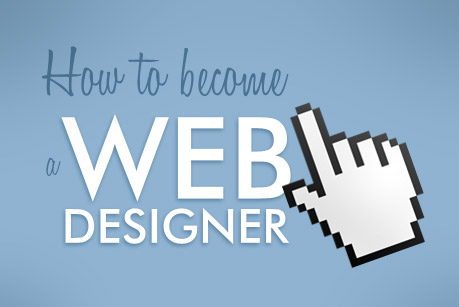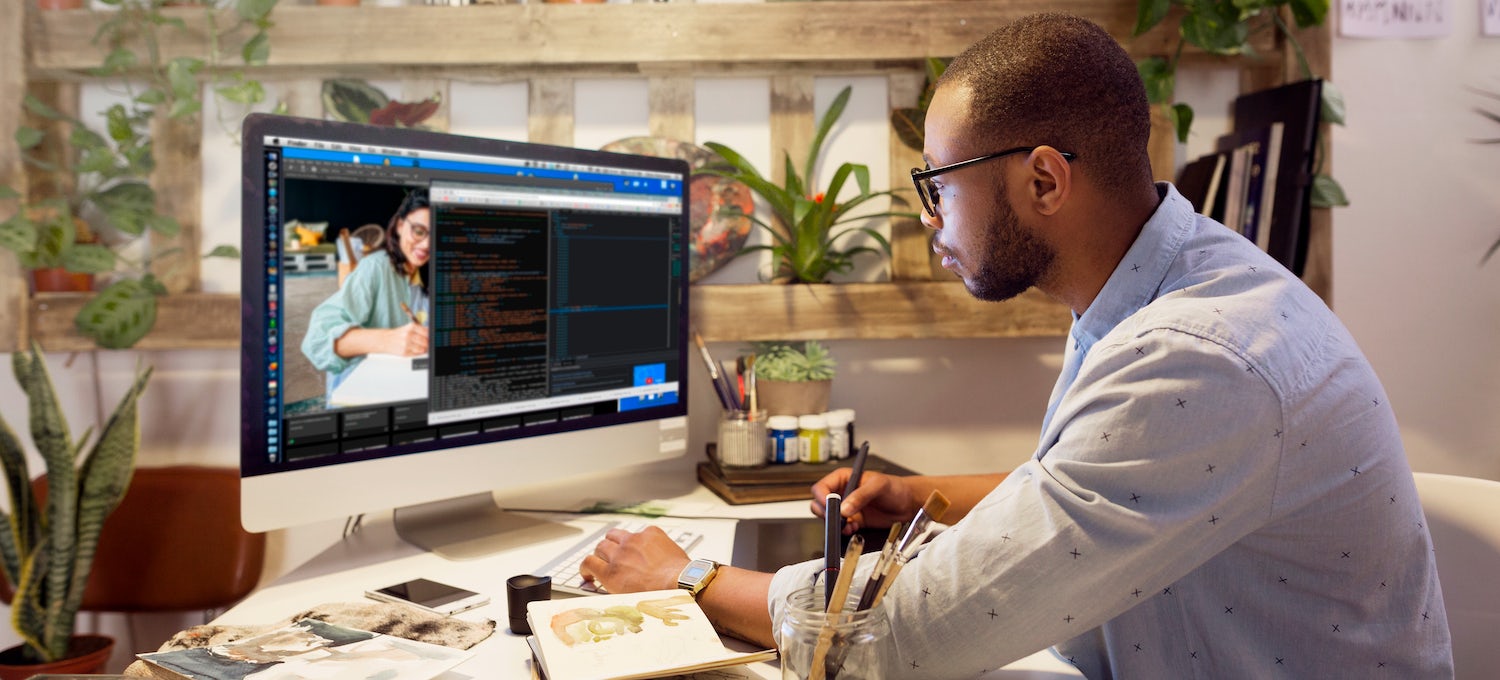How to become a Web Designer, you must have the technical and creative skills necessary to create visually appealing websites. You should be proficient in HTML, CSS, JavaScript and other web design programs such as Adobe Dreamweaver or Photoshop. Additionally, knowledge of user experience (UX) principles is essential for creating effective sites that are easy to use.
To build your portfolio of work it can help to volunteer with non-profits or local businesses who may need assistance building websites. This will give you valuable hands-on experience that will look great on your resume when applying for jobs. It’s also important to stay up-to-date with the latest trends in web design so reading industry blogs and attending conferences or workshops can be beneficial in helping you learn new techniques and develop your skillset even further.
- Learn the Basics of Web Design: Before you can become a professional web designer, it’s important to understand the basics of web design and development
- This includes learning HTML and CSS (Cascading Style Sheets), which are two core programming languages used for creating websites
- You should also learn how to use various software tools such as Adobe Photoshop, Illustrator, Dreamweaver and other popular programs that are commonly used in website design
- Develop Your Skills: Once you have learned the basics of web design, it’s time to build on your skillset by taking more advanced courses or pursuing an educational program related to web design or coding
- It is also recommended that you attend workshops or conferences related to this field so that you can stay up-to-date with the latest trends in website development and coding techniques
- Build Your Portfolio: As soon as possible, start building a portfolio showcasing some of your best work as a designer or developer
- This will help potential employers evaluate your skill level when considering whether they would like to hire you for their projects or not
- The portfolio should include samples from both client projects and personal projects if available so that employers can get an accurate understanding of your range capabilities as a designer/developer
- 4 Get Certified: To make yourself stand out among other applicants when applying for jobs in this field, consider getting certified by one of several organizations offering certifications related specifically to website design/development such as W3Schools Certification Program (WC3) , Microsoft Certified Solutions Developer (MCSD), Apple Professional Certifications etc
- These certifications demonstrate proficiency in particular aspects associated with designing websites which may be beneficial when competing against other candidates who do not have these credentials
- 5 Apply For Jobs : After preparing all necessary materials needed for job applications including resume , cover letter etc
- , begin searching online job portals such as Indeed , Glassdoor etc
- , networking events , social media platforms and industry specific classified sites etc
- , looking out for open positions related specifically with website designing & developing roles
- Remember even though having prior experience is always beneficial but many companies prefer hiring freshers due their enthusiasm towards work & ability grasp quickly newer concepts & technologies within short span time frame

Credit: www.awwwards.com
What Qualifications Do I Need to Be a Web Designer?
To become a successful web designer, there are certain qualifications that you need to have. First and foremost, an understanding of the fundamentals of design is essential. This includes knowledge of color theory, typography, composition and layout principles.
You should also be well-versed in HTML coding and website development techniques such as CSS and JavaScript because these will be used to create the finished product. Additionally, familiarity with various software programs for graphics creation such as Adobe Illustrator or Photoshop can be beneficial when it comes to creating logos or other graphical elements for websites. A good eye for detail is also important so that any mistakes or errors stand out during the design process.
Lastly, staying up-to-date on new trends in web design technology is important as this helps ensure that your designs remain modern and relevant over time.
How Long Does It Take to Become a Web Designer?
Becoming a web designer is no easy feat. It requires dedication, hard work and an eye for design. But just how long does it take to become a web designer?
The answer depends on many factors including your current skill level, the type of website you are designing and the amount of time you can dedicate to learning new skills.
For someone with little or no experience in coding or web design, becoming a professional web designer could take anywhere from six months to two years. However, those who already have some knowledge in HTML, CSS and JavaScript may be able to transition into full-time website development within just three months after acquiring additional training or certification courses.
The key is finding the right balance between theoretical knowledge and practical application while focusing on building strong core skills like HTML5 markup language, page layout using CSS3 (Cascading Style Sheets) rules and interactive features through JavaScript programming language. Once these foundational elements are mastered one should begin creating websites by utilizing popular platforms such as WordPress or Wix that offer quick solutions for non-technical users without sacrificing functionality or aesthetics.
Overall, becoming proficient enough at web design that one can make a career out of it will require both time and effort but with determination anyone can make their dreams come true!
Can I Teach Myself to Be a Web Designer?
Yes, you can teach yourself to be a web designer! With the right tools and resources, anyone with some basic computer skills can learn how to create a website from scratch. All it takes is dedication and determination.
There are several websites out there that offer tutorials on web design basics such as HTML, CSS, and JavaScript. You could also take online courses or read books related to building websites. Once you have learned the fundamentals of web design, you should focus on honing your skills by creating sample pages until they look just like what you want them to look like in real life applications.
Additionally, getting feedback from other professional web designers can help refine your work even further. Lastly, keeping up with new trends in technology will ensure that your website looks modern and relevant for years to come!
Is It Hard to Become a Website Designer?
Becoming a website designer can be quite challenging, but it is not impossible. It requires a combination of strong technical skills and creativity, so you must have an aptitude for both in order to succeed. A degree or certificate in web design or development may help you gain the necessary knowledge and experience required to become a successful website designer.
Additionally, having a good understanding of coding languages such as HTML, CSS, JavaScript and PHP will give you an edge when designing websites. Furthermore, having some basic knowledge of graphic design software like Photoshop is essential for creating attractive visuals on your sites. Of course, staying up-to-date with the latest trends in web design will also serve you well—you should always strive to push yourself further and remain ahead of the competition!
With hard work and dedication though, anyone has the potential to become a great website designer!
Web Design: The Complete guide to getting started in 2022
Web Designer Salary
The average salary for a Web Designer is $73,204 per year in the United States. Salaries range from $41,766 to $114,843 depending on experience and location. Highly experienced web designers can earn up to six figures or more while entry-level positions may start at around $50K per year.
How to Become Web Designer With No Experience
Becoming a web designer with no experience can seem like an intimidating task, but it is possible to do so with the right knowledge and resources. Start by learning coding languages such as HTML, CSS, JavaScript and more. You should also learn about design principles such as typography, color theory and user interface design.
Additionally, familiarize yourself with tools that are used in web design including Adobe Photoshop or Sketch. Finally, practice your skills by creating mockups of websites or designing personal projects for friends or family members. With dedication and hard work you will be able to become a successful web designer without any prior experience!
How to Become a Web Designer Without a Degree
Becoming a web designer without a degree is possible if you have the right skill set and drive. To become successful, it is important to focus on developing the necessary technical skills such as coding, user experience design, and visual design. It can also be helpful to gain work experience through freelance jobs or internships so that you can demonstrate your capabilities to potential employers.
Additionally, networking with professionals in the industry can help you learn more about the profession and open up opportunities for further growth within your career.
How to Become Web Designer from Home
If you are looking to become a web designer from the comfort of your own home, there are several steps that you should take. First, make sure you have the necessary technical skills like HTML and CSS coding as well as experience with design tools such as Adobe Photoshop or Illustrator. You will also need to create a portfolio showcasing your best work, be familiar with various content management systems (CMS), and stay up-to-date on current trends in web design.
Once these prerequisites have been met, you can begin marketing yourself by utilizing social media outlets and networking sites such as LinkedIn to connect with potential clients. With time and dedication, becoming a successful web designer from home is within reach!
Web Designer Vs Web Developer
Web designers are responsible for the visual layout of a website, while web developers are responsible for writing code to make the website functional. Web designers use HTML, CSS and other design tools to create visually appealing websites that users can interact with, while web developers use programming languages such as JavaScript to build features like search boxes or databases. Both roles require knowledge of coding languages and an understanding of user experience principles.
Google Web Designer
Google Web Designer is a powerful, free web development platform that enables users to create engaging and interactive HTML5 websites, ads and other content with an easy-to-use visual interface. With Google Web Designer, you can quickly design professional looking web pages without any coding knowledge. You can use its drag-and-drop tools to add text, shapes and images to your projects.
It has advanced features such as animation timeline control for animating elements on the page and built in support for popular ad networks such as DoubleClick Studio and AdWords.
Become a Web Designer in 10 Days
Becoming a web designer in 10 days is possible if you have the right resources and dedication. It will require an intense work ethic and strong knowledge of programming languages like HTML, CSS, JavaScript, JQuery, etc., as well as graphic design principles. You should also be familiar with content management systems such as WordPress or Drupal to create modern websites efficiently.
Finally, it is important to stay up-to-date on industry trends by reading articles and tutorials online or attending conferences. With the proper guidance and effort over a ten day period, anyone can become a successful web designer!
How to Get into Web Design With No Experience
If you’re interested in getting into web design but don’t have any experience, it’s still possible to break into the field. Start by taking online courses and tutorials to build your knowledge of coding languages like HTML and CSS. Additionally, get familiar with other tools such as Photoshop or Illustrator that will help you create website designs.
Finally, start creating small projects for yourself or friends and family to practice what you’ve learned and gain real-world experience. With a combination of education, skill development, and portfolio building – anyone can become a successful web designer!
Conclusion
In conclusion, becoming a web designer is an exciting opportunity to enter the digital world and make your mark. With some knowledge in coding languages, creative thinking skills, and a basic understanding of marketing strategies, you can become a successful web designer with dedication and hard work. It’s important to stay ahead of trends by continuing your education on the latest technologies so that you can be competitive within the industry.
With these tips in mind, you’ll be well on your way to achieving success in this field!






